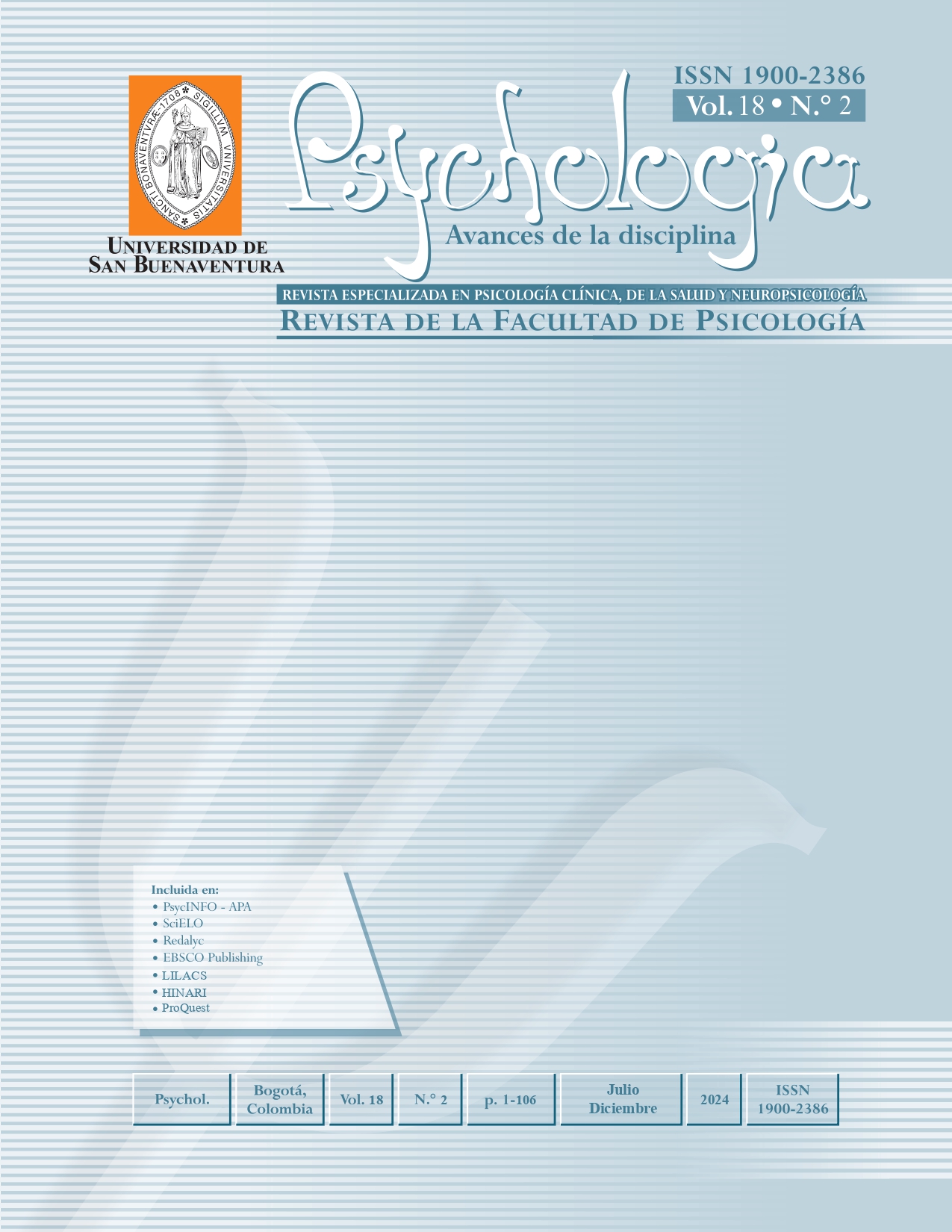Esta revista proporciona un acceso abierto inmediato a su contenido, basado en el principio de que ofrecer al público un acceso libre a las investigaciones ayuda a un mayor intercambio global de conocimiento.
Por tanto se acoge a la Licencia Creative Commons 4.0 Atribuciones Reconocimiento – NoComercial – CompartirIgual (by-nc-sa): No se permite un uso comercial de la obra original ni de las posibles obras derivadas, la distribución de las cuales se debe hacer con una licencia igual a la que regula la obra original.
http://creativecommons.org/licenses/by-nc-sa/4.0/
Resumen
The evidence on the relationships between aggression and empathy is unclear in the literature. A recent meta- analysis indicated that associations are limited, while repeated research in recent years has reported both positive and negative correlations. This systematic review seeks to establish the current evidence on different studies that have been conducted on the relationships between proactive and reactive aggressive behavior and empathy, from the cognitive and affective subdomains, in adolescents, youth and young adults. Method: Systematic review according to PRISMA guidelines. Results: 8 articles were found that met the inclusion and exclusion criteria described and discrepancies between the associations of the two variables addressed are reported. Conclusion: there seems to be a certain degree of acceptance of the inhibitory role of empathy against aggression, particularly that of affective empathy. No conclusive results were found for cognitive empathy with the different types of aggression.
Palabras clave:
Referencias
Anastassiou-Hadjicharalambous, X., & Warden, D. (2008). Physiologically-indexed and self-perceived affective empathy in conduct-disordered children high and low on callous-unemotional traits. Child psychiatry and human development, 39 (4), 503-517. https://doi.org/10.1007/s10578-008-0104-y
Andreu, JM., Peña, ME, & Penado, M. (2013). Impulsividad cognitiva, conductual y no planificadora en adolescentes agresivos reactivos, proactivos y mixtos. Anales de Psicología, 29(3), 734-740. https://dx.doi.org/10.6018/analesps.29.3.175691
Andreu-Rodríguez, JM., Peña, ME., & Ramírez, JM. (2009). Cuestionario de agresión reactiva y proactiva : un instrumento de medida de la agresión en adolescentes. Revista de Psicopatología y Psicología Clínica, 14 (1), 37-49. https://doi.org/10.5944/rppc.vol.14.num.1.2009.4065
Arango-Tobón, OE., Montoya Zuluaga, PA., Puerta Lopera, IC., & Sánchez Duque, JW. (2014). Teoría de la mente y empatía como predictores de conductas disociales en la adolescencia. Escritos de Psicología, 7 (1), 20-30. http://dx.doi.org/10.5231/psy.writ.2013.2810
Blair R. (2018). Traits of empathy and anger: implications for psychopathy and other disorders associated with aggression. Philosophical transactions of the Royal Society of London. Series B, Biological sciences, 373 (1744), 20170155. https://doi.org/10.1098/rstb.2017.0155
Blair R. J. (2013). The neurobiology of psychopathic traits in youths. Nature reviews. Neuroscience, 14 (11), 786–799. https://doi.org/10.1038/nrn3577
Bo, S., Abu-Akel, A., Kongerslev, M., Haahr, UH., & Bateman, A. (2014). Mentalizing mediates the relationship between psychopathy and type of aggression in schizophrenia. The Journal of nervous and mental disease, 202(1), 55-63. https://doi.org/10.1097/NMD.0000000000000067
Brown, SJ., Walker, K., Gannon, TA., & Keown, K. (2013). Creating a psychologically comfortable position: The link between empathy and cognitions in sex offenders. Journal of Sexual Aggression, 19 (3), 275-294. https://doi.org/10.1080/13552600.2012.747223
Card, NA., & Little, TD. (2007). Differential relations of instrumental and reactive aggresssion with maladjustment: Does adaptivity depend on function? In P.H. Hawley, TD., Little, PC., & Rodkin, (Eds.), Aggression and adaptation: The bright side to bad behavior (107-134). Mahwah, NJ: Lawrence Erlbaum.
Chen, FR., Fung, ALC., & Raine, A. (2019). The cognitive, affective, and somatic empathy scales (CASES): Cross-cultural replication and specificity to different forms of aggression and victimization. Journal of Personality Assessment, 103 (1), 80–91. https://doi.org/10.1080/00223891.2019.1677246
Coccaro EF., Sripada CS., Yanowitch RN., Phan, KL. (2011) Corticolimbic function in impulsive aggressive behavior. Biological psychiatry, 69(12), 1153–1159. https://doi.org/10.1016/j.biopsych.2011.02.032
Davis, MH. (1980). A multidimensional approach to individual differences in empathy. JSAS Catalog of Selected Documents in Psychology, 10, 2–19.
Davis, MH. (1994). Empathy: A social psychological approach. Madi son: Brown & Benchmark Publishers.
De Ridder, J., Pihet, S., Suter, M., & Caldara, R. (2015). Empathy in institutionalized adolescents with callous-unemotional traits: An ecological momentary assessment study of emotion recognition. Criminal Justice and Behavior, 43 (5), 653–669. https://doi.org/10.1177/0093854815618431
Decety J. (2010). The neurodevelopment of empathy in humans. Developmental neuroscience, 32 (4), 257– 267. https://doi.org/10.1159/000317771
Deschamps, PK., Verhulp, EE., de Castro, BO., & Matthys, W. (2018). Proactive aggression in early school‐ aged children with externalizing behavior problems: A longitudinal study on the influence of empathy in response to distress. American Journal of Orthopsychiatry, 88 (3), 346-353. https://doi.org/10.1037/ort0000319
Dodge, KA., & McCourt, SN. (2010). Translating models of antisocial behavioral development into efficacious intervention policy to prevent adolescent violence. Developmental psychobiology, 52 (3), 277–285. https://doi.org/10.1002/dev.20440
Dollard, J., Doob, LW., Miller, NE., Mowrer, OH., & Sears, RR. (1939). Frustration and aggression. New Haven: Yale University Press. https://doi.org/10.1037/10022-000
Dryburgh, NS., & Vachon, DD. (2019). Relating sex differences in aggression to three forms of empathy. Personality and Individual Differences, 151, 109526. https://doi.org/10.1016/j.paid.2019.109526
Eisenberg N. (2000). Emotion, regulation, and moral development. Annual review of psychology, 51, 665- 697. https://doi.org/10.1146/annurev.psych.51.1.665
Eisenberg, N., Eggum, ND., & Di Giunta, L. (2010). Empathy-related responding: Associations with prosocial behavior, aggression, and intergroup relations. Social Issues and Policy Review, 4 (1), 143– 180. https://doi.org/10.1111/j.1751-2409.2010.01020.x
Euler, F., Steinlin, C., & Stadler, C. (2017). Distinct profiles of reactive and proactive aggression in adolescents: Associations with cognitive and affective empathy. Child and Adolescent Psychiatry and Mental Health, 11 (1), 1. https://doi.org/10.1186/s13034-016-0141-4
Helfritz-Sinville, L. E., and Stanford, M. S. (2014). Hostile attribution bias impulsive and premeditated aggression. Personality and Individual Differences. 56, 45-50. https://doi.org/10.1016/j.paid.2013.08.017
Jolliffe D, & Farrington DP (2006). Examining the relationship between low empathy and bullying. Aggressive Behavior, 32 (6), 540–550. https://doi.org/10.1002/ab.20154
Liberati, A., Altman, DG., Tetzlaff, J., Mulrow, C., Gøtzsche, PC., Ioannidis, JP., Clarke, M., Devereaux, PJ.,
Kleijnen, J., & Moher, D. (2009). The PRISMA statement for reporting systematic reviews and meta-analyses of studies that evaluate health care interventions: explanation and elaboration. PLoS medicine, 6 (7), 000100. https://doi.org/10.1371/journal.pmed.1000100
López Romero, L., Romero, E., & González Iglesias, B. (2011). Delimitando la agresión adolescente: Estudio diferencial de los patrones de agresión reactiva y proactiva. Revista Española De Investigación Criminológica, 9, 1-29. https://doi.org/10.46381/reic.v9i0.59
Lovett, BJ., & Sheffield, RA. (2007). Affective empathy deficits in aggressive children and adolescents: a critical review. Clinical psychology review, 27(1), 1–13. https://doi.org/10.1016/j.cpr.2006.03.003
Lozano A., & Ostrosky, F. (2011). Desarrollo de las Funciones Ejecutivas y de la Corteza Prefrontal. Revista Neuropsicología, Neuropsiquiatría y Neurociencias, 11(1), 159-172.
Mestre, V., Frías, MD., & Samper, P. (2004). La medida de la empatía: análisis del Interpersonal Reactivity Index. Psicothema, 16(2), 255-260.
Milone, A., Cerniglia, L., Cristofani, C., Inguaggiato, E., Levantini, V., Masi, G., Paciello, M., Simone, F., & Muratori, P. (2019). Empathy in Youths with Conduct Disorder and Callous-Unemotional Traits.
Neural plasticity, 2019, 9638973. https://doi.org/10.1155/2019/9638973
Odgers, CL., & Russell, MA. (2009). Can adolescent dating violence be prevented through school-based programs?. Archives of pediatrics & adolescent medicine, 163 (8), 767–768. https://doi.org/10.1001/archpediatrics.2009.129
Organización Mundial de la Salud (2014). Informe sobre la Prevención Mundial de la Violencia. Global Status Report on Violence Prevention
Penado, M. (2012). Agresividad reactiva y proactiva en adolescentes: efecto de los factores individuales y socio - contextuales.
Penado, M., Andreu, JM., & Peña, E. (2014). Agresividad reactiva, proactiva y mixta: Análisis de los factores de riesgo individual. Anuario de Psicologia Jurídica. 24 (1), 37–42. https://doi.org/10.1016/j.apj.2014.07.012
Peña, ME., Andreu, JM., Barriga, A., & Gibbs, J. (2013). Psychometrical properties of the “How I Think” Questionnaire (HIT-Q) in adolescents. Psicothema. 25 (4), 542-548. doi
Poulin, F., & Boivin, M. (2000). The role of proactive and reactive aggression in the formation and development of boys' friendships. Developmental Psychology, 36(2), 233–240. https://doi.org/10.1037/0012-1649.36.2.233
Raine, A., Dodge, K., Loeber, R., Gatzke-Kopp, L., Lynam, D., Reynolds, C., Stouthamer-Loeber & Liu, J. (2006). The reactive-proactive aggression questionnaire: Differential correlates of reactive and proactive aggression in adolescent boys. Aggressive Behavior, 32(2), 159–171. https://doi.org/10.1002/ab.20115
Renouf, S., Brendgen, M., Seguin, J.R., Vitaro, F., Boivin, M., Dionne, G., Tremblay, R.E. & Perusse, D. (2010). Interactive links between theory of mind, peer victimization, and reactive and proactive aggression. Journal of Abnormal Child Psychology, 38(8), 1109–1123. https://doi.org/10.1007/s10802-010-9432-z
Riasat, R., Khawar, R., Ghayas, S., Fatima, A., & Saeed, S. (2017). Empathy as a Mediator of Relationship between Emotional Intelligence and Aggression among Juvenile Delinquents and Non-Delinquents, Pakistan Journal of Criminology, 9 (4) 58-77.
Romero, E., Kapralos, P & Gómez-Fraguela, XA. (2016). Rasgos psicopáticos infanto-juveniles: evaluación e implicaciones en un estudio prospectivo. Anuario de Psicologia Juridica, 26 (1), 51–59. https://doi.org/10.1016/j.apj.2016.03.002
Singer T. (2006). The neuronal basis and ontogeny of empathy and mind reading: review of literature and implications for future research. Neuroscience and biobehavioral reviews, 30 (6), 855–863. https://doi.org/10.1016/j.neubiorev.2006.06.011
Song, P., Zhang, Z., Wang, B., David, N., Zhao, H., Wang, Q., Xiao, Y., & Yang, B. (2018). The influence of trait empathy on reactive aggression: An ERP study. International journal of psychophysiology: official journal of the International Organization of Psychophysiology, 133, 102–110. https://doi.org/10.1016/j.ijpsycho.2018.08.002
Tampke, EC., Fite, PJ., & Cooley, JL. (2020). Bidirectional associations between affective empathy and proactive and reactive aggression. Aggressive Behavior, 46(4), 317–326. https://doi.org/10.1002/ab.21891
Taylor S. P. (1967). Aggressive behavior and physiological arousal as a function of provocation and the tendency to inhibit aggression. Journal of personality, 35 (2), 297–310. https://doi.org/10.1111/j.1467-6494.1967.tb01430.x
Vachon, DD., Lynam, DR., & Johnson, JA. (2014). The (non)relation between empathy and aggression: Surprising results from a meta-analysis. Psychological Bulletin, 140 (3), 751-753. doi:10.1037/a0035236
Van Hazebroek, BCM., Olthof, T., & Goossens, FA. (2016). Predicting aggression in adolescence: The interrelation between (a lack of) empathy and social goals. Aggressive Behavior, 43 (2), 204-214. https://doi.org/10.1002/ab.21675
Vitaro, F., Brendgen, M., & Tremblay, RE. (2002). Reactively and proactively aggressive children: antecedent and subsequent characteristics. Journal of child psychology and psychiatry, and allied disciplines, 43(4), 495–505. https://doi.org/10.1111/1469-7610.00040
Volavka, J. (1995). Neurobiology of violence. American Psychiatric Press.
Wai, M., & Tiliopoulos, N. (2012). The affective and cognitive empathic nature of the dark triad of personality. Personality and Individual Differences, 52(7), 794–799. https://doi.org/10.1016/j.paid.2012.01.008
Walter, H. (2012). Social cognitive neuroscience of empathy: concepts, circuits, and genes. Emotion Review, 4 (1) 9-17. https://psycnet.apa.org/doi/10.1177/1754073911421379
Zabala, ML., Richard's, MM., Breccia, F., & López, M. (2018). Relaciones entre empatia y teoría de la mente en niños y adolescentes. Pensamiento Psicológico, 16 (2), 47-57. https://dx.doi.org/10.11144/javer¡anacal¡.ppsi16-2.retm
Zhang, F.-f., Dong, Y., & Wang, K. (2010). Reliability and validity of the Chinese version of the Interpersonal Reactivity Index -C. Chinese Journal of Clinical Psychology, 18(2), 155–157.





















